serverless-auto-swagger-desc-example v2.3.9
Serverless Auto Swagger with description, example
Forked from Serverless Auto Swagger. This plugin allows you to automatically generate a swagger endpoint, describing your application endpoints. This is built from your existing serverless config and typescript definitions, reducing the duplication of work.
Install
yarn add --dev serverless-auto-swagger-desc-example
# or
npm install -D serverless-auto-swagger-desc-exampleAdd the following plugin to your serverless.yml or serverless.ts:
plugins:
- serverless-auto-swagger-desc-exampleplugins: ['serverless-auto-swagger-desc-example'];Usage
This plugin is designed to work with vanilla Serverless Framework. All you need to do is add this plugin to your plugin list and it will generate the swagger file and add the endpoints required. When you deploy your API, your new swagger UI will be available at https://{your-url-domain}/swagger.
You can also run sls generate-swagger if you want to generate the swagger file without deploying the application.
Config Options
All config options are optional. Defaults are shown in the table below.
custom:
autoswagger:
apiType: 'http' | 'httpApi'
generateSwaggerOnDeploy: true | false
typefiles: ['./src/types/typefile1.d.ts', './src/subfolder/helper.d.ts']
swaggerFiles: ['./doc/endpointFromPlugin.json', './doc/iCannotPutThisInHttpEvent.json', './doc/aDefinitionWithoutTypescript.json']
swaggerPath: 'string'
apiKeyHeaders: ['Authorization', 'anyOtherName']
useStage: true | false
basePath: '/string'
schemes: ['http', 'https', 'ws', 'wss']
excludeStages: ['production', 'anyOtherStage']| Option | Description | Default | Example |
|---|---|---|---|
generateSwaggerOnDeploy | Boolean which indicates whether to generate a new swagger file on deployment | true | |
typefiles | Array of strings which defines where to find the typescript types to use for the request and response bodies | ./src/types/api-types.d.ts | |
swaggerFiles | Array of string which will merge custom json OpenApi 2.0 files to the generated swagger | [] | |
swaggerPath | String for customize swagger path. Your new swagger UI will be available at https://{your-url-domain}/{swaggerPath} | swagger | my-swagger => https://{your-url-domain}/my-swagger |
apiType | API type for which your Swagger UI and Swagger JSON lambdas should be deployed. Options are http and httpApi | httpApi | |
apiKeyHeaders | Array of strings used to define API keys used in auth headers | [] | apiKeyHeaders: ['Authorization', 'x-api-key'] |
useStage | Boolean to either use current stage in beginning of path or not | false | true => dev/swagger for stage dev |
basePath | String that can be prepended to every request. Should include leading / | - | /some-base => http://localhost/some-base/my-endpoint |
schemes | Array (containing one of http, https, ws, or wss) for specifying schemes | Scheme used to serve the API specification (reflecting Swagger's behavior) | |
excludeStages | Array of strings that contains stages in which Swagger UI and Swagger JSON lambdas should not be deployed in. | [] |
Adding more details
The default swagger file from vanilla Serverless framework will have the correct paths and methods but no details about the requests or responses.
API Summary and Details
The optional attributes summary and description can be used to describe each HTTP request in Swagger.
swaggerTags is an optional array that can be used to group HTTP requests with a collapsible name
(i.e. grouping two endpoints GET /dogs and POST /dogs together).
If not specified, all HTTP requests will be grouped under default.
http: {
summary: 'This is a cool API',
description: 'Cool API description is here',
swaggerTags: ['Dogs']
}Adding Data Types
This plugin uses typescript types to generate the data types for the endpoints. By default, it pulls the types from src/types/api-types.d.ts.
You can then assign these typescript definitions to requests as bodyType on the http or https config, or to the response as seen just below.
Description, Example value
You can specify the model description and example value with suffix. ( _DESC / _EXAMPLE )
_DESCand_EXAMPLEare optional.
export interface Flight {
id: string;
id_DESC: 'You can write description for your model';
id_EXAMPLE: 'cy.lee';
age: number;
age_DESC: 'You can write description for your model';
age_EXAMPLE: 30;
}
//or you can use type as well
export type Flight = {
id: string,
id_DESC: 'You can write description for your model',
id_EXAMPLE: 'cy.lee',
age: number,
age_DESC: 'You can write description for your model',
age_EXAMPLE: 30
};The example value and description will already be entered in the swagger as below.
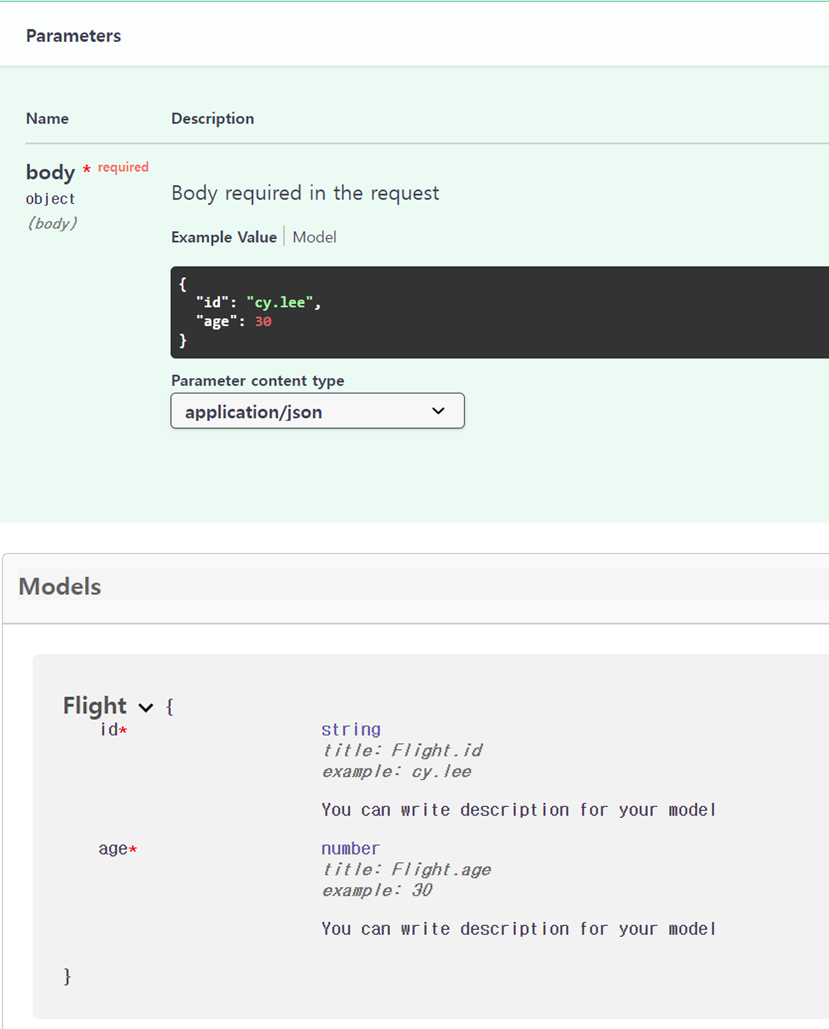
Example can also be defined in queryStringParameter and pathParameter
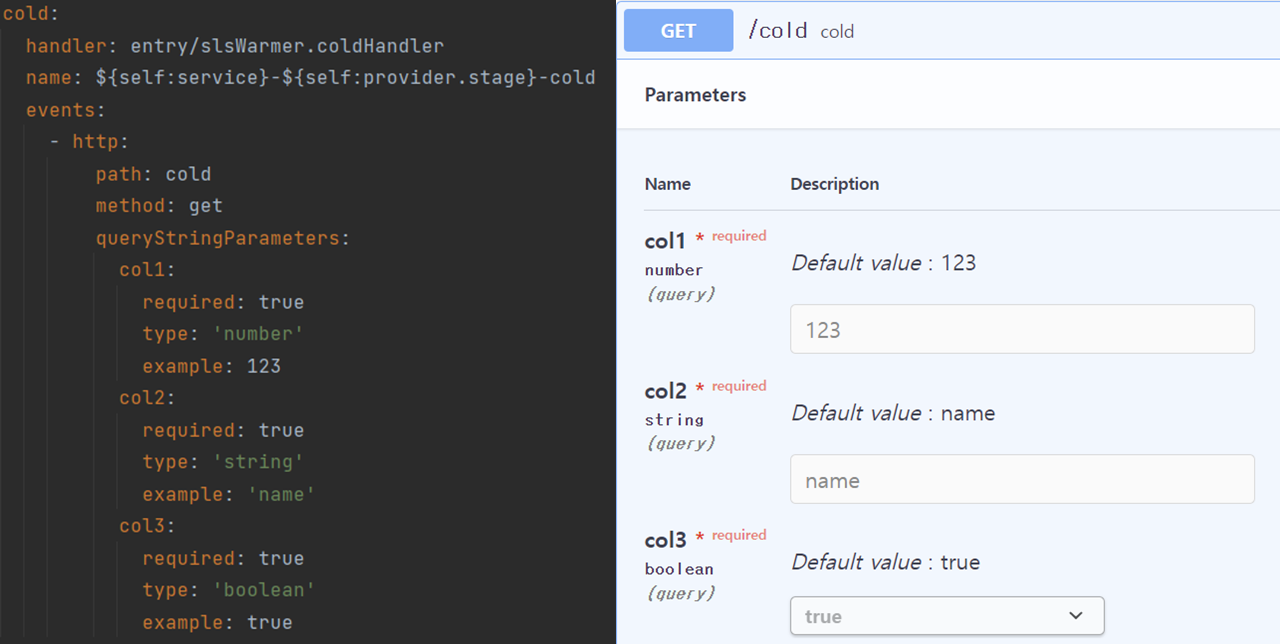
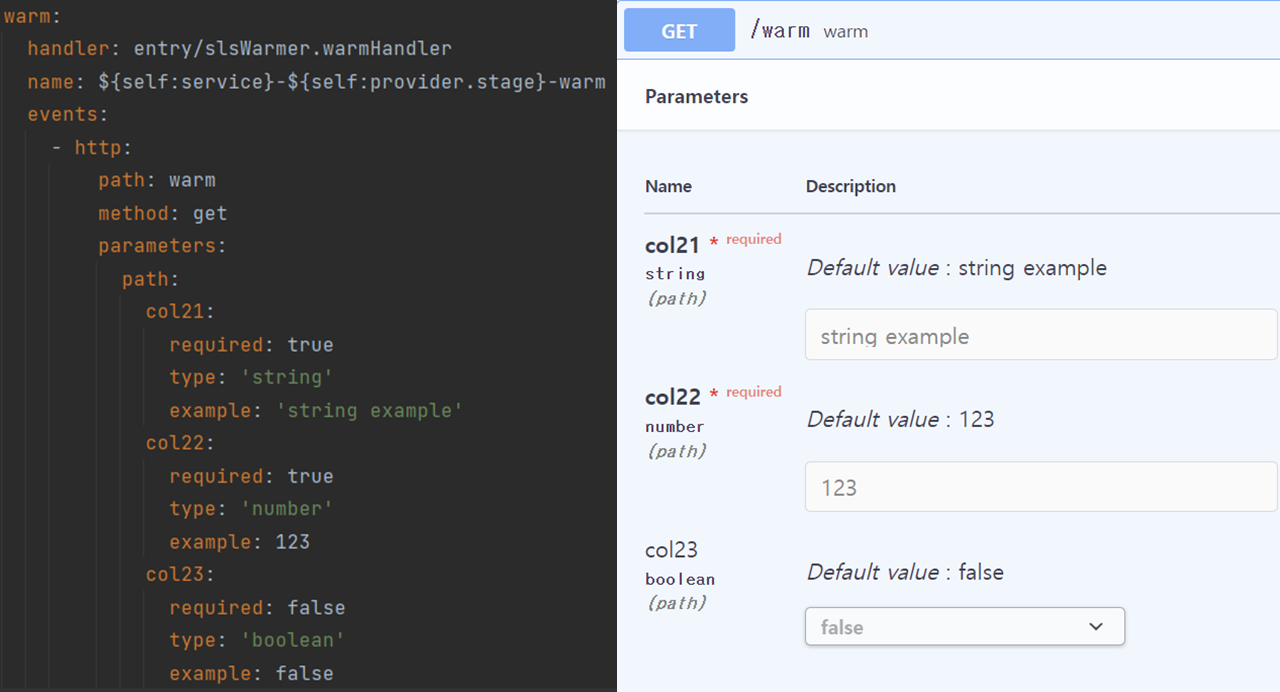
Extend model
The model can be extended by reusing the previously defined model.
export type name = {
name: string
name_DESC: 'this is user name.'
name_EXAMPLE: 'cy.lee'
}
export type age = {
age: number
age_DESC: 'this is user age'
age_EXAMPLE: 30
}
export type user = name & age & {
github: string;
github_DESC: 'this is github address'
github_EXAMPLE: 'https://github.com/2CHAN0/'
}Try to reuse the model like below.
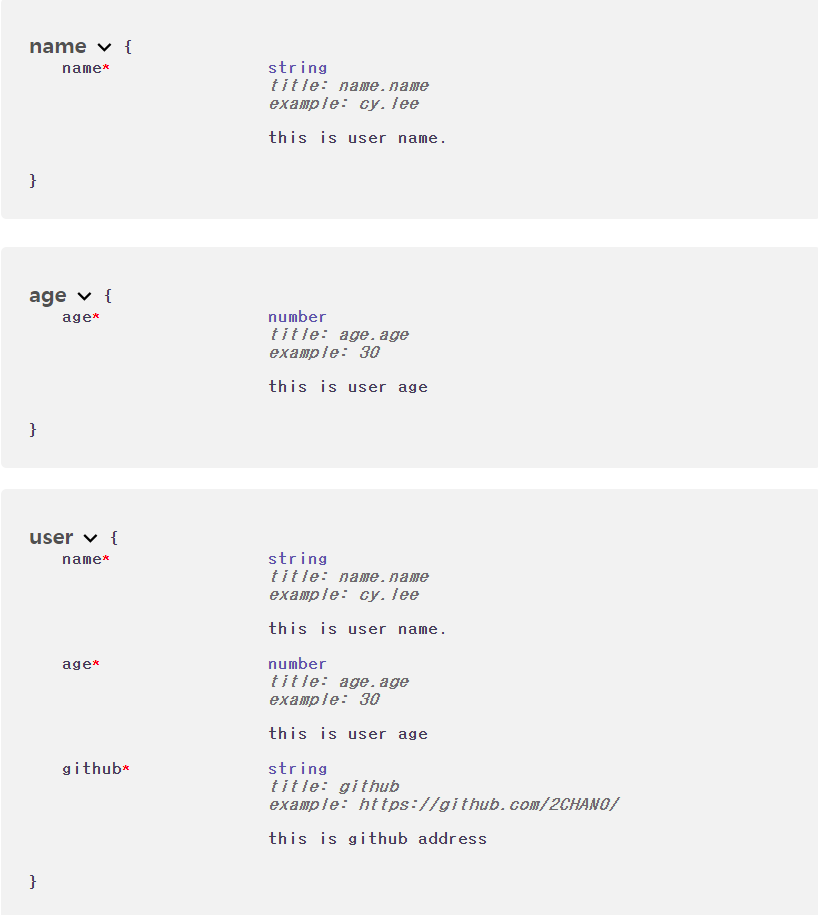
Responses
You can also add expected responses to each of the http endpoint events. This is an object that contains the response code with some example details:
responseData: {
// response with description and response body
200: {
description: 'this went well',
bodyType: 'helloPostResponse',
},
// response with just a description
400: {
description: 'failed Post',
},
// shorthand for just a description
502: 'server error',
}Post request expected body
When you create a POST or PUT endpoint, you expect to receive a specific structure of data as the body of the request.
You can do that by adding a bodyType to the http event:
http: {
path: 'hello',
method: 'post',
cors: true,
bodyType: 'helloPostBody',
}Query String Parameters
If you want to specify the query string parameters on an endpoint you can do this by adding an object of queryStringParameters to the event (original I know). This has two required properties of required and type as well as an optional description.
http: {
path: 'goodbye',
method: 'get',
queryStringParameters: {
bob: {
required: true,
type: 'string',
description: 'bob',
},
count: {
required: false,
type: 'integer',
},
},
},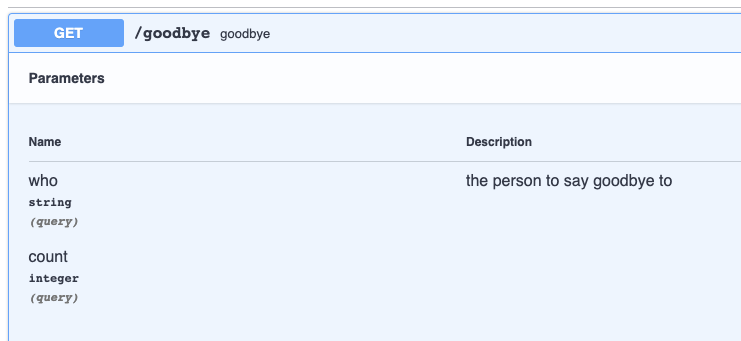
Multi-Valued Query String Parameters
If you use multi-value query string parameters (array), then you must specify that your type is array and specify your data type (string or integer) in arrayItemsType
http: {
path: 'goodbye',
method: 'get',
queryStringParameters: {
bob: {
required: true,
type: 'array',
arrayItemsType : 'string',
description: 'bob',
},
count: {
required: false,
type: 'array',
arrayItemsType : 'integer',
},
},
},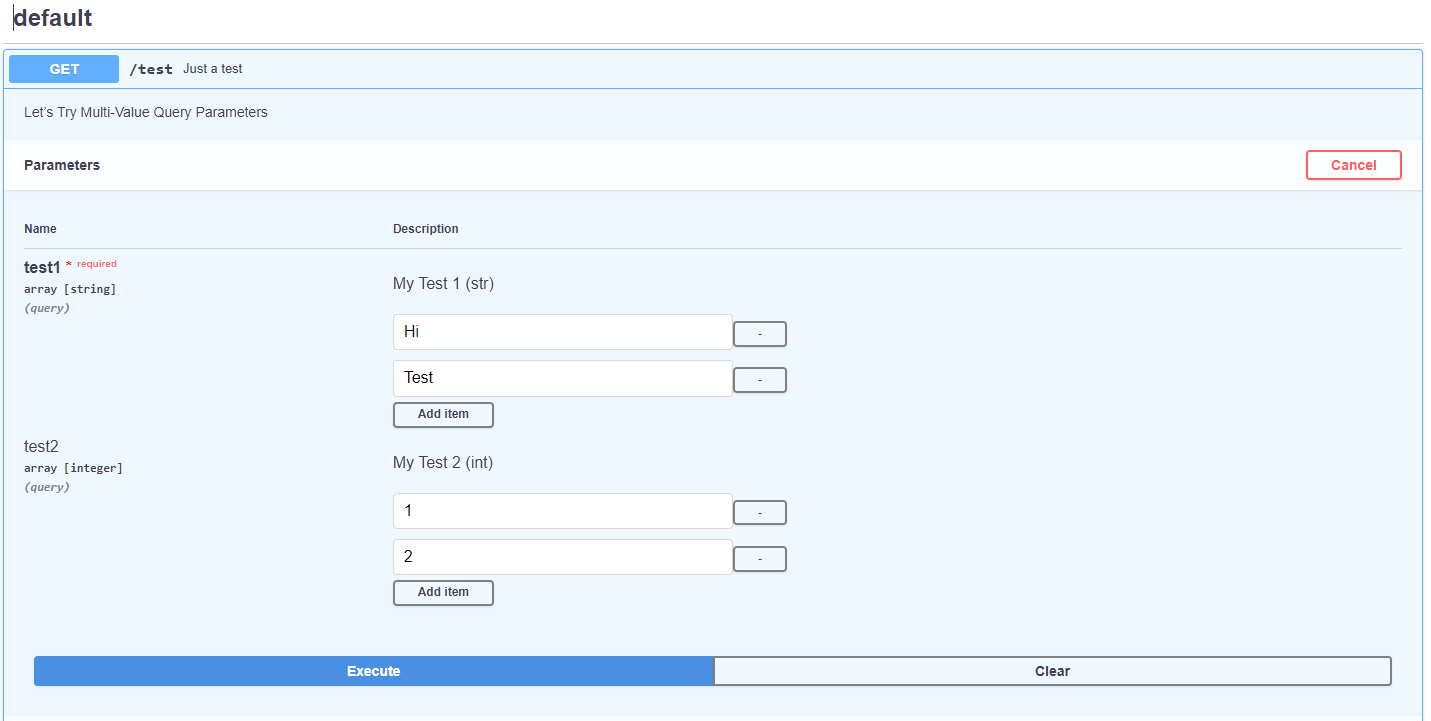
Header Params
Works the same way as queryStringParameters, but for headers.
To use it, just define it under headerParameters:
http: {
path: 'goodbye',
method: 'get',
headerParameters: {
bob: {
required: true,
type: 'string',
description: 'bob',
},
count: {
required: false,
type: 'integer',
},
},
},Exclude an endpoint
You can exclude some endpoints from the swagger generation by adding exclude to the http event:
http: {
path: 'hello',
method: 'post',
exclude: true,
}with Serverless Offline
In the plugin list, you must list serverless-auto-swagger before the serverless-offline plugin. If you don't you won't get the required endpoints added to your local endpoints.